SUMMARY
This is AI generated summarization, which may have errors. For context, always refer to the full article.
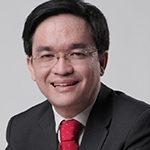
For several weeks in August, it was extremely tiresome to go for meetings in Quezon City or Pasig from my residence in Makati. Like many folks in Metro Manila, I have had to cope with horrible traffic especially in EDSA.
I noticed that travelling even short distances in the Metro has become a nightmare, sometimes taking hours, instead of quarter to half an hour, especially during rush hour.
Three decades ago, I used to live also in Makati. I fondly remember that as a high school student, it would take me only fifteen minutes to twenty minutes to reach La Salle Green Hills. Now, doing such a trip from Makati to Ortigas in twice that time is already a very big blessing. There are still some days though, such as last August 21 (as it was a holiday then), when travelling throughout Metro Manila can be a breeze, but normally, one has to endure what Dan Brown calls “the gates of hell” in (Metro) Manila.
A study by the Japan International Cooperation Agency (JICA) suggested that in 2012, traffic congestion was costing the country 2.4 billion pesos daily, and this could more than double to 6 billion pesos daily by 2030 unless we come up with a “dream plan” for Metro Manila and its surrounding areas.
Traffic an effect of prosperity?
What are the reasons for traffic?
The administration’s anointed for 2016, a former Secretary of the Department of Transportation and Communications (DOTC), asserts that traffic is a mere effect of the country’s new found economic growth prosperity. Is the anointed merely wiggling his way out of this mess that he may have had a hand in or is this really something unmanageable? If there is no way out of the traffic, then what is a DOTC for?
Stating that traffic is a “high class problem”, i.e., a reflection of economic activity and prosperity, suggests that this is beyond the control of government. The simple logic about the claim is more money means more power to buy cars, and more cars means more traffic.
But this is far too simplistic as there are some places such as Singapore and Hongkong that are far more prosperous than Metro Manila, but while they do experience traffic in those areas, it isn’t as bad as what we have to endure daily in the Metro.
Should we make the “anointed” accountable for this lack of foresight and inaction during his term as DOTC Secretary (that has continued in the current leadership at DOTC), and make him pay by finding someone else for 2016 who has the heart to solve the problem and who has had “no experience” about it (as against those with experience but have done nothing)?
The current DOTC Secretary Joseph Emilio Abaya, added more harm to this analysis of traffic suggesting that traffic is not fatal anyways, although he later apologized for these nonchalant and insensitive remarks. Recently, he even changed his tune. Medical doctors warn that traffic can actually be bad for our health, and even fatal given the pollution and the stress that we can get from it.
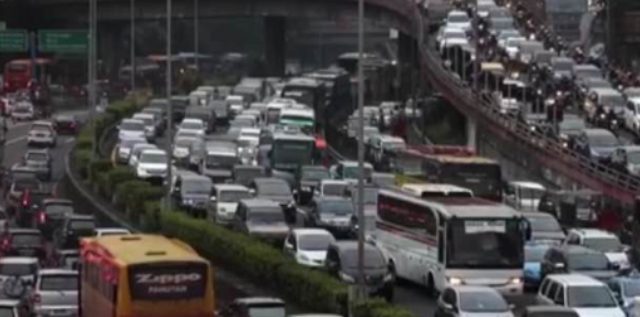
Coping with technology, social media
A few years ago, I used to get peeved when people would apologize when they would come late for a meeting because of traffic. I used to think that one merely has to allow for additional time for traffic to arrive on time for meetings. However, these days estimating the time to account for traffic can be quite a feat in itself.
I thank technologies such as the Waze app for guiding me to finding alternative routes, but if everyone were using Waze, then everyone else would be using these same routes. If Waze can’t speed up my travel on the road, I, at least, use technology to keep me busy, lurking through posts on Facebook, Instagram, Twitter, etc., or check my emails and messages on Viber.
Aside from helping us cope with traffic, social media has also managed to provide us quick information about conditions on the ground. Marciano Gatmaitan, a cousin, took a photo of buses clogging the streets, and posted a Facebook shoutout with the photo : “Need to say more why we have traffic?”
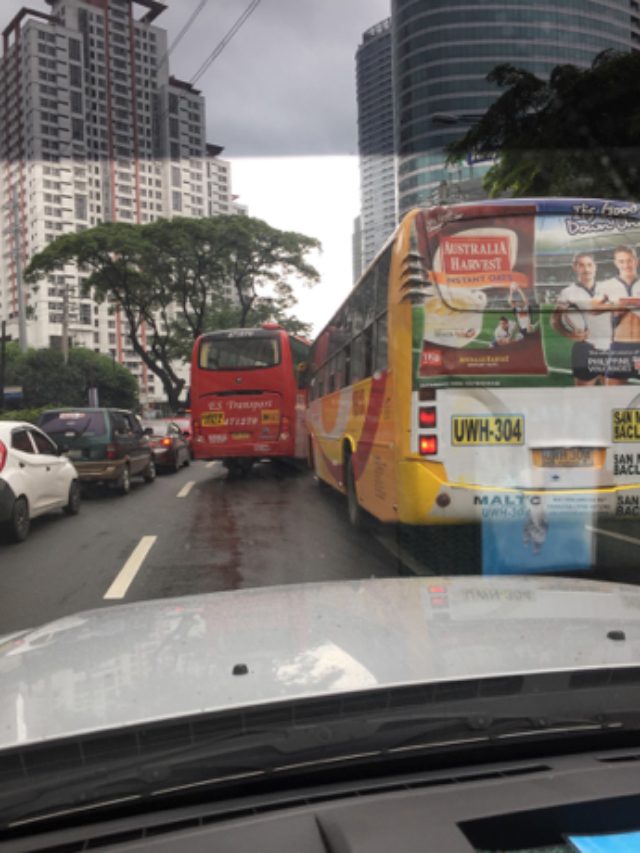
Government has now started to pay more serious attention to this problem by having Cabinet Secretary Rene Almendras become traffic czar, rerouting southbound buses from EDSA to C5, and making use of the Highway Patrol Group (HPG) for enforcing traffic in EDSA starting last September 7.
The first day of the rerouting and use of the HPG suggested there was an easing in half of the six choke points of Metro Manila. Immediately, I thought this would likely not last long as people are just recognizing there are new “rules” in the traffic game. When the rules are learned, it may go back to “normal.” Several people in social media have reported that the other three choke points have not eased up, and new choke points are appearing. The second night September 8, commuters were not any better for traffic. After heavy rains, so many complained that they have been stranded.
My suspicion that traffic would not get any better even with the HPG around is borne from the recognition that while there certainly is evidence of poor road behavior in EDSA, especially among buses, whose drivers behave like this way because they are on commissions rather than wages, this is only part of the entire story.
Confluence of factors
There is really a confluence of factors that lead to traffic, beyond economic prosperity and people’s behavior on the streets. Part of that confluence is the poor public transport system and the volume of vehicles.
The sorry state of public transport gives little alternatives for the middle and upper income classes than to buy a car and take one’s vehicle along EDSA and other streets in the Metro. Will one risk taking a long queue for the MRT (which has become even longer because of a systems change, which did not undergo effective transition)?
The other rail system, the LRT, is similarly problematic. Getting a bus will also drive you crazy with bus drivers waiting till eternity for their buses to get passengers, ironically sometimes clogging intersections and even highways, further reducing road space. Finding a taxi can be challenging, although now apps like GrabTaxi help in finding taxis especially for short distances.
Another major issue about traffic congestion is sheer vehicular volume, i.e. the number of vehicles in Metro Manila. Consider the rising number of sales of vehicles (see Figure 1), including passenger cars. Vehicle sales are increasing considerably also because it is now very affordable to purchase (especially with the low down payments).
Of late, there are about 25 thousand new cars every month, and the growth rate for private vehicles is now higher than that for commercial vehicles. Why would someone not want to buy a car, especially if public transport is horrible, aside from the added social prestige of having a vehicle?
Unfortunately, everyone thinks this way, and thus the volume of vehicles, coupled with the lack of public transport, plus poor road courtesy all contribute to the worsening of traffic in Metro Manila, especially EDSA. So, it is not just one issue that results in traffic conditions, and consequently, it is not a single action that will improve traffic conditions.
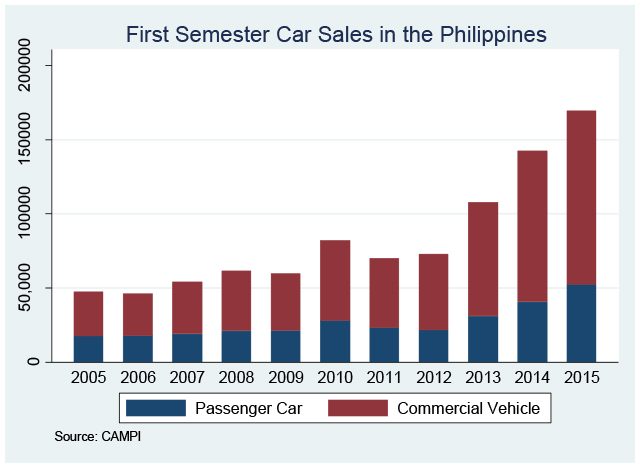
Bus transport sector
Sonny N. Domingo, Roehlano Briones and Debbie Gundaya, colleagues at the Philippine Institute of Development Studies (PIDS), released a discussion paper this year that described and studied the bus transport sector.
The study noted that in Metro Manila, a significant number of commuters use buses over other available modes of transport such as private vehicles, MRT, LRT, taxis, and utility vehicles. The study also pointed out that there are about over 12,500 buses operating within Metro Manila, or from the province to Metro Manila, dispersed over 1,122 bus operators.
Contrast this to the mid 1970s, when there were only 4 private consortia and one government entity (the then Metro Manila Transit Corporation) in charge of bus operations in Metro Manila, which grew to 14 groups by late 1970s, and further expanded in 1989 with the liberalization of the bus transport sector. With the rising congestion in Metro Manila, the government imposed a moratorium on the issuance of franchises for provincial buses in 2000, and a nationwide moratorium on all new buses and new franchises in 2003. But bus operators interviewed for the study claim that new franchises can actually be obtained, especially if they are willing to pay a fixer’s fee of P150,000 per unit.
The PIDS study indicates that “travel time [by bus] within (EDSA’s) super corridor – a 12-kilometer stretch – ranges from 18 to 138 minutes, depending on the level of traffic congestion at certain times of the day.” The average bus delay from the five kilometer stretch of Ayala to Guadalupe was estimated at 50 minutes, while the 4.3-kilometer-Guadalupe to Aurora Blvd. route took 43 minutes. The study estimated that the foregone wages, i.e., the opportunity cost of wasted time among passengers on the road, was P4.6 billion a year. The foregone wages of bus passengers daily along the Ayala-Guadalupe route alone was estimated at P11.3 million, while those using the Guadalupe-Aurora corridor was P8.97 million.
The study suggested several steps to reform the bus transport sector, including limiting the number of operating buses in franchised routes, and proper enforcement of these policies, especially on franchises agreements; giving incentives to operators for the deployment of the optimal number of buses. It would certainly be important to find ways of paying bus drivers regular wages rather than commissions to improve their road behavior.
Long-term solutions
Should government just build more roads to accommodate the growing number of vehicles? Traffic engineers and urban planners have learned in the last few decades that we cannot really build our way out of congestion. The number of roads themselves is partly causing the traffic.
Ironically, more roads (with the status quo in place) will just mean more cars. Professor Emeritus Josefina Alvarez of New Mexico State University, a mathematician argues quite interestingly that fewer roads lead to less traffic.
Essentially using various paradoxes, this mathematician shows that when there is a new road, drivers try to minimize their travel time and use the new road, and unfortunately, everyone has the same idea, and this affects the road network, yielding to congestion in the new road. Fewer roads, according to Professor Alvarez, would lead to a cooperative strategy of sorts, and ironically less travel time. Many development organizations, including the Asian Development Bank, have likewise also pointed out that solving traffic in urban areas is not merely about having more roads.
It is clear there are a lot of cars on EDSA, and one might be tempted to think that merely removing all the private cars, or minimizing them further with schemes such as those adopted in Jakarta that require vehicles to have at least four passengers would be enough to discourage people from using their cars. Certainly, there must be mechanisms in place to discourage the purchase and use of cars, but what alternative is there in place? We certainly cannot fly like Superman, or use a teleporter as in StarTrek, at least not yet.
A “system view” should really be taken. Urban planner Benjamin de la Pena points out that government officials should be prioritizing solutions that move more people instead of vehicles, and he encourages us to demand that government solve the problem.
He explains that “transportation… (is) not a problem of how a car gets from point A to point B. It’s a problem of how a person goes from point A to point B. We’ve been counting the movement of cars instead of focusing on the movement of people.” Currently, government has done very little to improve mass transit (both the bus system and rails) that could discourage the use of cars.
The paradigm continues to be purely about vehicle movement. Transportation is ultimately an issue about people, about the need for people to move, and the incentives and disincentives in choosing one transportation mode over the other. Thus, the long term solutions involve public transport, affordable housing, and if I may add, having fewer people in the Metro. In other countries, even schools are purposely established outside of the capital. Here, the locations of schools further contribute to an already bad traffic condition. Just go long along Ortigas, Taft Ave., and Katipunan, during schooldays, and you see what I mean.
Myanmar’s example
One of the reasons why I find it refreshing to visit Naypyidaw, Myanmar is that finding 20 vehicles in an eight lane-road in front of major hotels is already considered traffic.
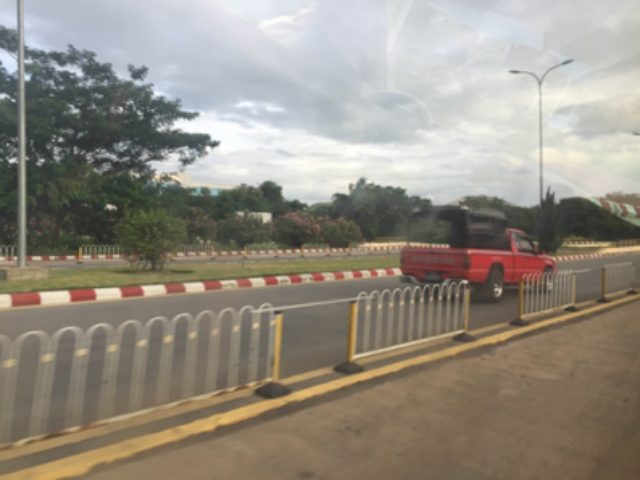
Naypyidaw, the administrative capital of Myanmar, is located about 320 kilometers north of Yangon, the previous capital. Established a decade ago in 2005, Naypyidaw was given a formal name in 2006. Government employees and officials are provided residences in the city, although many of them maintain residences in Yangon (as their children continue their schooling in the old capital).
Myanmar is not the only country among our neighbors that has created a new capital. Malaysia also has Putrajaya. Thailand, Indonesia and the Philippines have likewise considered the idea of establishing a new administrative capital, but these plans have remained as plans.
In the Philippines, a plan to transfer the government center outside of Metro Manila was actually already developed during the Marcos administration, and resurrected in the Ramos administration, but never put into action.
Decades ago, when Quezon City was established, it was also meant to become the administrative capital of the country. If the plan for a new government center takes more traction, the next question is where. Governor Joey Salceda of Albay, one of a few local chief executives who understands data very well, has recently advocated the transfer of the entire government machinery, including the presidential mansion, the offices of both houses of Congress, and other offices of the national government to Lucena.
I hope government officials really put concrete long term plans into action. Some officials claim that the “dream plan” for Metro Manila is starting, however, we are far from feeling this.
In addition, the dream plan does not look at volume of cars, which government should address, as has been done in Singapore. Understandably, this dream plan would not look into this as Japanese auto manufacturers would like the growth of car sales to continue. The past sins of omission have already caught up, and are clearly doing us harm.
More can and should be done to improve traffic conditions. If government officials continue to sit on the job, then next year, we will and should consider traffic as an election issue. We should demand better government, as we deserve better. – Rappler.com
Dr. Jose Ramon “Toots” Albert is a professional statistician. He is a Senior Research Fellow of the government’s think tank Philippine Institute for Development Studies, and the president of the country’s professional society of data producers, users and analysts, the Philippine Statistical Association, Inc. for 2014-2015. He finished a PhD in Statistics from the State University of New York at Stony Brook.
Add a comment
How does this make you feel?
There are no comments yet. Add your comment to start the conversation.